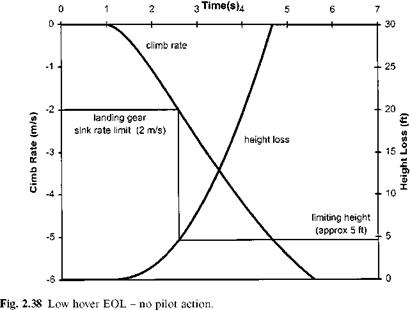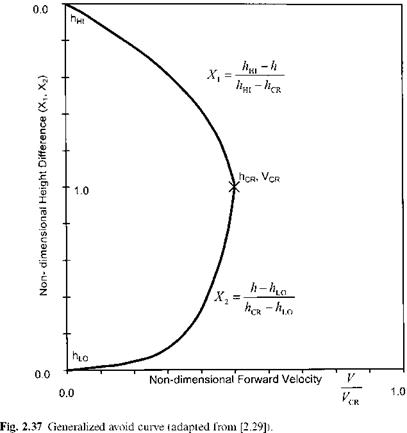Lower hover height
First estimation is made of the maximum height from which a vertical engine-off landing can be performed without damage to the undercarriage. This lower hover height, hLO, is calculated by assuming that the whole manoeuvre is conducted at a RoD equal to the limiting sink rate for the landing gear, VLG, and lasts as long as the energy stored in the rotor can be used to provide hover power. Since the rotor RPM will decay, as energy is bled away, the blade loading coefficient will rise even though the thrust produced will remain approximately constant. Thus the time available for the engine-off (which is analogous to the rotor decay time mentioned earlier) can be related to the ratio of the blade loading at the instant of engine failure to some nominal maximum value (Pegg [2.28] uses 0.2). Hence:
|
|
||
|
|||
|
|||
|
|
Consider a light helicopter fitted with an undercarriage stressed to accept a sink rate of 2 m/s and operating in SL-ISA conditions. Thus if I = 1000 kgm2, R = 5.25 m, Ab = 4.4 m2, m = 1800 kg, )nom = 39.8 rad/s, and PIGE = 191.7 kW, then hLO = 9.6 ft. It is of interest to compare this crude estimate with the results from a more sophisticated model. Using the equations developed above it is possible to predict the thrust developed and the torque required by the main rotor as a function of rotor speed and collective pitch. This data can then be used to predict the rate of descent, and subsequent height loss, following a power failure in the hover. Figure 2.38 shows the situation if the pilot elects to maintain the collective pitch fixed at its hover value.
Approximately 1.6 s after total power loss the helicopter is descending vertically at 2 m/s and has fallen 5 ft. Thus if the engine(s) were to fail at some higher hover height and the pilot failed to react, damage to the undercarriage would occur. In reality a higher value of hLO is allowable since the pilot can be expected to utilize the energy stored in the rotor to cushion the landing. This situation is shown in Fig. 2.39. Here the pilot allows the RoD to build up to the onset of incipient vortex ring (0.3vih) before rapidly raising the collective lever to reduce the vertical velocity. The height lost before the RoD reduces back to 2 m/s is around 12 ft. Thus if the pilot increases collective pitch rapidly at just the right time he can suffer a total power failure whilst hovering at about 10 ft without damage to the aircraft.
|

 20
20
18
16
14
12 £ 0 W
10 ° +•» Г
о Ш
8 о z












